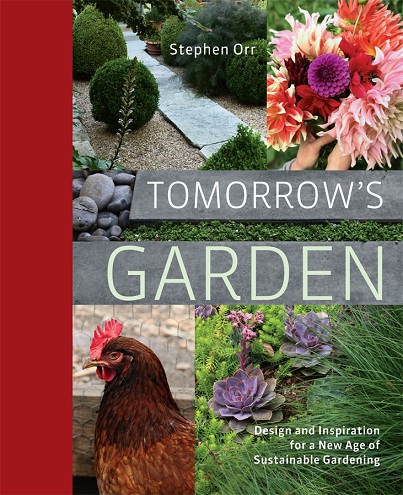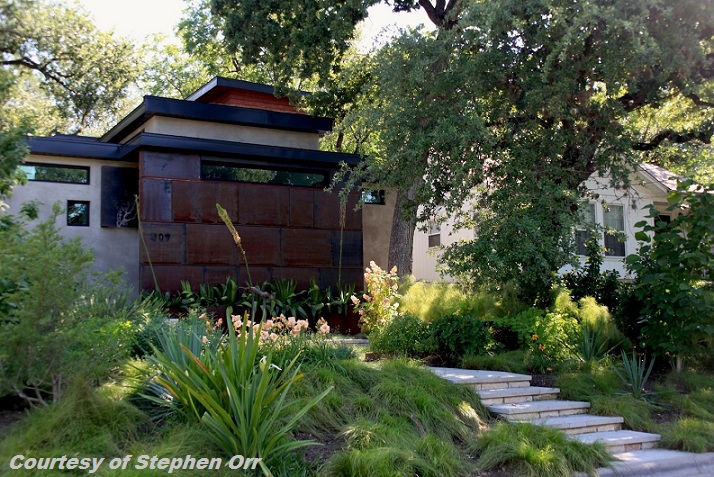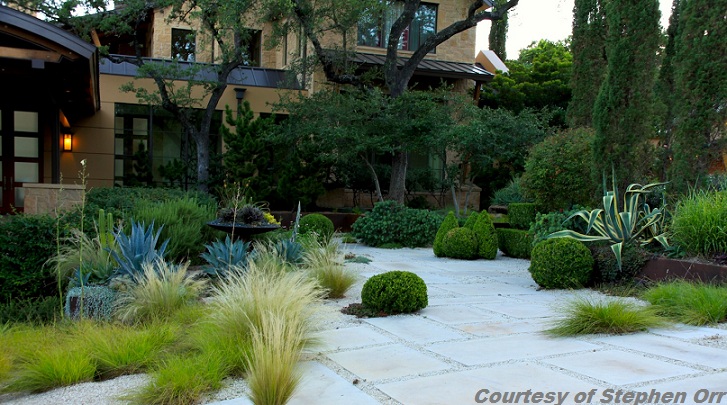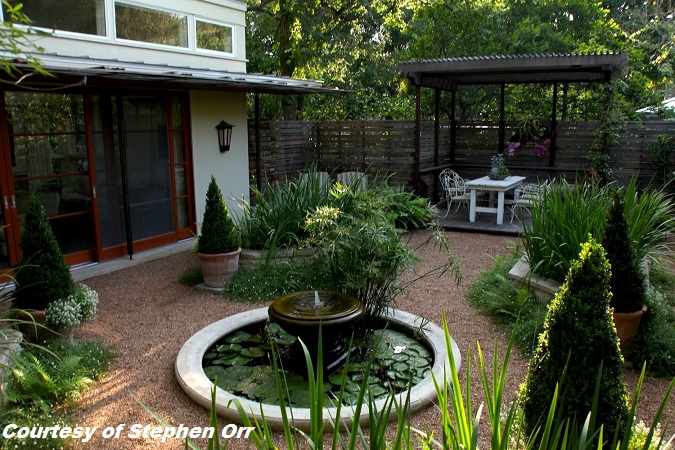Read This: Tomorrow’s Garden
I came of age as a gardener when the native-plant movement was already well-established, in a progressive city that encourages its citizens to harvest rainwater, recycle yard trimmings through a city composting program, replace lawn grass with xeric plantings, and forgo weed-and-feed chemical treatments for their lawns. So I’ve never known any other way to garden. Not that I’m a paragon of sustainable gardening, mind you, but I do what I can and strive to do better, all the while working to make my garden as beautiful as possible.
Stephen Orr, author of Tomorrow’s Garden: Design and Inspiration for a New Age of Sustainable Gardening, came at gardening from a far different perspective. As the gardening editorial director for Martha Stewart Living magazine, and formerly as a writer for the New York Times and garden editor for Domino and House & Garden, he has been privileged to visit many an extravagant, money-is-no-object garden. But over time their excesses began to weigh on him. His own environmental awakening coincided with introductions to gardeners and designers “who were making gardens with a conscience—sometimes even for the very wealthy.” Orr was inspired by these smaller, more sustainable, but still beautifully designed gardens.
Mark Word-designed garden, with sedges and a mix of soft and spiky plants subbing in for lawn grass.
He showcases 14 of them in Tomorrow’s Garden, and while California gardens get the lion’s share of attention, quite a few Austin gardens appear also. (All the images republished here are of Austin gardens featured in Orr’s book.) They are inspiring from a design standpoint as well as an environmental one. Make no mistake—these are still largely gardens for the wealthy. But they aren’t show-offy gardens that flaunt their extravagance. They embrace regionality, use less water than traditional landscapes, incorporate permeable flooring (gravel, in particular) to keep water on the property, and eschew sweeping lawns for more naturalistic plantings. Although these may be expensive gardens, they offer plenty of good design lessons for those of us gardening on a budget.
At this contemporary home, for example, designer Dylan Robertson discarded the tired concept of a foundation planting and lawn for an open patio-style garden of water-thrifty plants like Mexican feathergrass, agaves, and boxwood. Where an empty lawn and protective foundation hedge would have visually held visitors at arm’s length, this space is welcoming, with a paver-and-gravel path that opens up and embraces the street. Clipped boxwood balls and cones offer a structural counterpoint to the softly waving grasses, plus they contribute winter interest along with the agaves and other evergreen plants. And just think how much less water is required to maintain this xeric garden compared to a traditional St. Augustine lawn. Inspiring!
Yvonne Tocquigny’s garden, designed by Berthold Haas and Patrick Kirwin, also eschews lawn for a garden with inviting gravel paths and a central water feature in a formally structured garden. A restricted palette of evergreen plants in symmetrical raised beds simplifies maintenance. This is a low-maintenance garden, but look how gorgeous it is.
Stephen Orr, who hails from Abilene, returns to the state on Saturday, June 11, at 3 p.m. for a book signing at Book People in Austin. (Be warned: If you want him to sign your book, you must buy it from Book People and show proof of purchase.)
Disclosure: This book was sent to me for review by Rodale. My review, like everything in Digging, is my own honest opinion.
All material © 2006-2011 by Pam Penick for Digging. Unauthorized reproduction prohibited.






Very nice Pam, I can see how you would enjoy that style in your area. Always good to get new ideas and have visuals for your clients. I added it to WebGarden as well this am. Have a great day, Brooke
Thanks for the link at WebGarden, Brooke! —Pam
The 3rd pic of the patio, contrasting balls of boxwood and freeform agaves, grasses, so nice. Wow – who woulda’ thunk, that good design can work without reliance on flowers, too? Nice – great, another book I need to buy!
Who woulda thunk? We would! 🙂 I loved that design too, David. Maybe one day it’ll pop up on a garden tour so I can see it in person. —Pam
Ha! This is one of the two books I ordered recently. I’ve been hearing such good things about this book. You are a born reviewer, Pam. Stubborn clinging to foundation planting where it’s not needed gets my goat too. The Dylan Robertson garden is wonderful.
Thanks for the kind comment, Denise. This has been my book review week! I have one more coming up next Monday: Ivette Soler’s “The Edible Front Yard.” —Pam
Nice concepts for future and present gardens.
I think so too, Greggo. —Pam
This book is on my nightstand right now! I checked it out from the library but I’m loving it so much I might just have to buy it.
I knew this one would interest you, Loree. Are you going to review it at Danger Garden? I look forward to hearing what you think about it. —Pam
Stephen Orr has the most incredible eye for gardens that has been honed over decades of seeing the best of the best – but he is no snob! He is a Texan, by the way! We bonded over our Texas roots at a swanky restaurant in LA one tawdry evening long ago … I think his book is a classic, and will be pointing the way for future gardeners to follow in their trip down their own garden path!
And I agree, Pam – even though alot of the gardens in his book belong to the hoity – toity, the lessons in it are for all of us! Great review, as ALWAYS!
XOXOXO
The tawdry evening sounds like fun, Ivette. 😉 I heard Stephen speak at the Wildflower Center last year, and his talk was really interesting. He’s going to be in Austin again for a book signing at Book People this Saturday. —Pam
Pam, I love these gardens~You’re right there are many ideas that even gardeners on a tight budget could implement. gail
It’s all in knowing how to look at it, right, Gail? I’m definitely taking away some ideas from these gardens. —Pam
These are lovely gardens, and they make me proud to live in Austin. The next question is, how do those of us who have a moderate budget borrow from the ideas in these gardens? What can we take away to use in our own garden when we don’t have funds for big-ticket landscape items? For example, the round concrete fountain/pond is gorgeous, as are the steps in the first house photo. How could those features be re-created on a budget by the do-it-yourself-er without the help of a designer? Thanks, Pam!
Laura, that’s a great idea for a post. I’ll try to address your question sometime soon! —Pam
I love the examples from the book, and definitely need to get a copy of it. Certainly his ideas are modifiable for smaller budget garden, too.
I wish I was able to get to Garden Writers this year to hear what he has to say there — we all need to think more about true sustainability in our gardens.
He seems to be doing some traveling, Lisa. Maybe he’ll be speaking in a city near you in the future. —Pam
Hi Pam,
Sounds like my kind of book, especially since it has a CHICKEN on the front cover. That’s my newest addition in our continuing quest for a natural garden. I’m currently using their bedstraw in the compost pile and it has made a BIG difference. Compost GOLD!
The photos in this book are really beautiful and I like your comments about the conscious decisions to conserve verses the money-is-no-object ideology. The drought certainly forces the issue on water conservation, doesn’t it? All the more reason to align one’s garden with what Nature intended. A natural garden can be beautiful, but it’s a more subtle beauty and it takes some getting used to.
Excellent post!!!
David/ Tropical Texana
P.S. Another book I love is Plant Driven Design by Ogden
I like Plant-Driven Design too, David. I reviewed it a while back; click on the link. —Pam
This looks like a great book. I tend to pass by a lot of things since we have such an established garden but this looks like it would be an inspiration and fun as well.